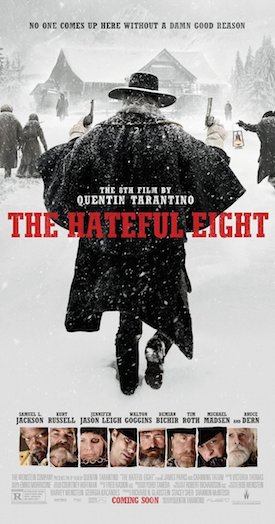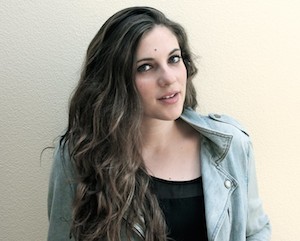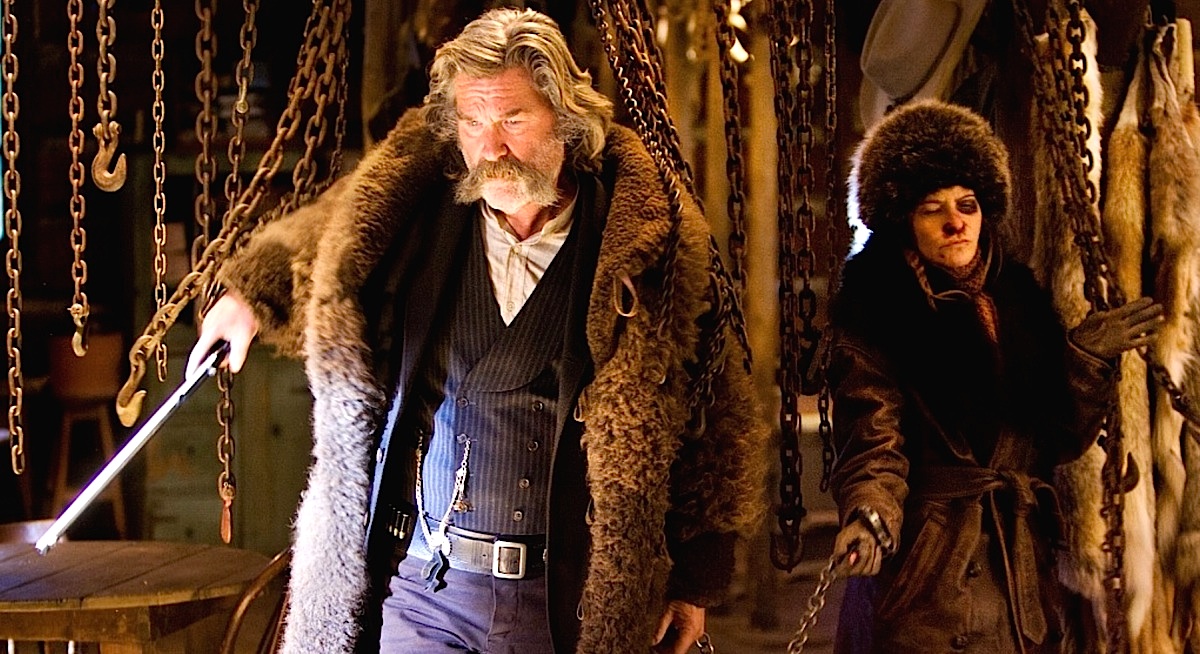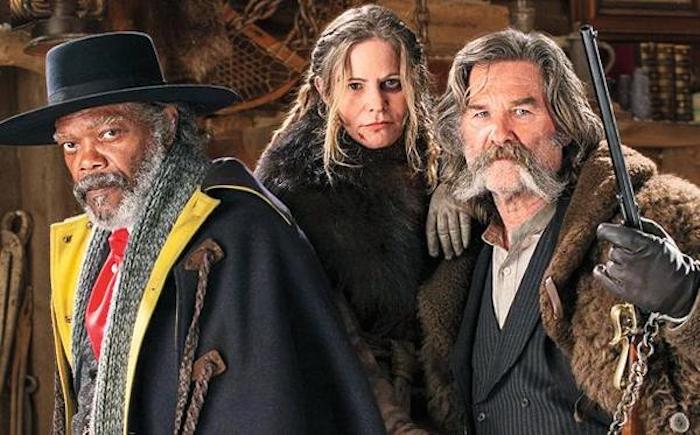I was lucky enough to attend the premiere of Quentin Tarantino’s new film, The Hateful Eight, at the Cinerama Dome in Hollywood, “the theater it was made for,” as he said that evening in his very enthusiastic introduction. The film was supposed to play at the Dome its 70mm roadshow version beginning on Christmas Day before those plans were scuttled (much to Tarantino’s disappointment) by an agreement Arclight had with Disney for Star Wars: The Force Awakens. Too bad, even though it’s still playing in 70mm at other Arclight venues and a selection of specially outfitted theaters across the country. And trust me, it’s worth seeking out this gloriously Tarantino-esque film in its special 70mm roadshow presentation — it is spectacular.
 Taking place in Wyoming a few years after the Civil War, The Hateful Eight focuses on bounty hunter John Ruth (Kurt Russell) and his fugitive Daisy Domergue (Jennifer Jason Leigh). They are racing towards the town of Red Rock where Ruth, known in these parts as “The Hangman,” will bring Domergue to justice. Along the road, they encounter two strangers: Major Marquis Warren (Samuel L. Jackson), a black former union soldier turned infamous bounty hunter, and Chris Mannix (Walton Goggins), a southern renegade who claims to be the town’s new Sheriff. Losing their lead on the blizzard, Ruth, Domergue, Warren and Mannix seek refuge at Minnie’s Haberdashery, a stagecoach stopover on a mountain pass. When they arrive at Minnie’s, they are greeted not by the proprietor but by four unfamiliar faces. Bob (Demian Bichir), who’s taking care of Minnie’s while she’s visiting her mother, is holed up with Oswaldo Mobray (Tim Roth), the hangman of Red Rock, cow-puncher Joe Gage (Michael Madsen), and Confederate General Sanford Smithers (Bruce Dern). As the storm overtakes the mountainside stopover, our eight travelers come to learn they may not make it to Red Rock after all… Written and directed by Quentin Tarantino, The Hateful Eight also features Channing Tatum, James Parks, Dana Gourrier, Zoë Bell, Gene Jones, Keith Jefferson, Lee Horsley, Craig Stark, and Belinda Owino.
Taking place in Wyoming a few years after the Civil War, The Hateful Eight focuses on bounty hunter John Ruth (Kurt Russell) and his fugitive Daisy Domergue (Jennifer Jason Leigh). They are racing towards the town of Red Rock where Ruth, known in these parts as “The Hangman,” will bring Domergue to justice. Along the road, they encounter two strangers: Major Marquis Warren (Samuel L. Jackson), a black former union soldier turned infamous bounty hunter, and Chris Mannix (Walton Goggins), a southern renegade who claims to be the town’s new Sheriff. Losing their lead on the blizzard, Ruth, Domergue, Warren and Mannix seek refuge at Minnie’s Haberdashery, a stagecoach stopover on a mountain pass. When they arrive at Minnie’s, they are greeted not by the proprietor but by four unfamiliar faces. Bob (Demian Bichir), who’s taking care of Minnie’s while she’s visiting her mother, is holed up with Oswaldo Mobray (Tim Roth), the hangman of Red Rock, cow-puncher Joe Gage (Michael Madsen), and Confederate General Sanford Smithers (Bruce Dern). As the storm overtakes the mountainside stopover, our eight travelers come to learn they may not make it to Red Rock after all… Written and directed by Quentin Tarantino, The Hateful Eight also features Channing Tatum, James Parks, Dana Gourrier, Zoë Bell, Gene Jones, Keith Jefferson, Lee Horsley, Craig Stark, and Belinda Owino.
Key in helping to create the unique look of the film was costume designer Courtney Hoffman and her wonderfully outlandish get-ups. Hoffman was familiar with Tarantino’s style of working from her work on Django Unchained as Christop Waltz’s personal costumer and was delighted to take on this much bigger challenge. I sat down with her to talk about The Hateful Eight.
Danny Miller: I get the impression that Quentin Tarantino is the kind of filmmaker who gets extremely involved in every aspect of his films, including costume design.
 Courtney Hoffman: Oh, completely, you have no idea! A long time ago Robert De Niro told him, “I find my character when I put on my shoes.” Because of that, Quentin decided he’d go to every fitting. With most directors you present photos and maybe samples of fabrics, and so on, but Quentin is physically in the room for every single fitting — and with plenty of ideas and opinions! But it was great. The truth is, those fittings are the time for the actors to really explore their characters, and because Quentin is the parent of those characters, it only made sense that he was there to help shape that.
Courtney Hoffman: Oh, completely, you have no idea! A long time ago Robert De Niro told him, “I find my character when I put on my shoes.” Because of that, Quentin decided he’d go to every fitting. With most directors you present photos and maybe samples of fabrics, and so on, but Quentin is physically in the room for every single fitting — and with plenty of ideas and opinions! But it was great. The truth is, those fittings are the time for the actors to really explore their characters, and because Quentin is the parent of those characters, it only made sense that he was there to help shape that.
Does he include a lot of specific costume references in the script?
Yes, it definitely starts with the script. It’s such an interesting process. And believe me, if Quentin writes something in the script, whether it’s someone pulling out their handkerchief or checking their pocket watch, you better have those things there!
Even to the point of describing the color of a certain costume?
Oh yeah, absolutely. One of the first references I remember reading in the script was about Sam’s calvary coat. Quentin said he should be “dressed like a Lee Van Cleef type,” and that Oswaldo Mowbray was a small foppish English man in a three-piece gray suit. For some movies, you end up throwing all those script notes out when you actually get down to designing the costumes but with Quentin there is almost no note that doesn’t end up happening. Some directors are like, “Okay, what do you have in mind?” but with Quentin, it’s more like, “What do you mean you didn’t read that note on page 37?”
I recently interviewed Sandy Powell for Carol and she said she ignores all of those notes about costumes in the script unless there’s a really good plot-based reason for it.
With Quentin you better have it memorized! Another note I remember was that Daisy Domergue had been trying to board a boat to Italy when John Ruth caught her — which is something you’d never know as a viewer! — so she was wearing a man’s winter coat. That’s why her coat in the film doesn’t really fit her that well. In this case, as a costume designer, the script really becomes your bible. I could have gotten it all tattooed on my arm and a year later, I wouldn’t regret it. I’d just say, “Yeah, that was perfect!”
It’s true that Tarantino’s scripts are particularly fun to read.
Completely — every note is just pure Quentin! Some of my best memories are of him reading me his scripts, the way he brings them to life. At the start of this script, it says, “In glorious 70mm.” It was there in black and white from the very beginning so everyone, from Harvey Weinstein on down, knew what he was planning and that it wasn’t really negotiable.
This film takes place in a specific time period, obviously, but it also kind of creates its own world in time and space. I know some films are obsessed with using accurate period details — how was it on this?
Having been a costumer on Django, I knew, for example, that if Quentin wanted a French maid to be wearing taffeta at the Cleo Club with Calvin Candie, that was what we were going to do! We weren’t so much making a period movie as we were a Tarantino movie. But if we do go with something anachronistic, it’s not random or by accident, there’s going to be a big discussion about it. I remember the discussion about the buttons on Sam’s calvary coat. Those usually have gold buttons but in order to keep the vagueness of whether he got drummed out of the calvary or not, I ended up taking the buttons off. It worked because he’d had the coat for several years and during the Civil War, people often used buttons as a kind of currency. We wanted it to be kind of vague, but it was a specific choice.
The cool thing about Tarantino is that there’s the period in which the film takes place but it’s also a kind of period piece from the world of 1970s movies.
Exactly, that’s what I was about to say, too! Carlos Simi and his work in the spaghetti western genre was probably my biggest reference for this film. Also Il Grande Silenzio is a wonderful spaghetti western that takes place in the snow that Quentin showed us. He wanted us to see they way they used fur and pelts and real horsehair — just amazing.
You are obviously more involved with the actors than most people. Did they have a lot of input with their costumes?
I loved these actors, we had such an emotional connection. Seeing them become these characters was a real personal responsibility for me. But, of course, the reality for this film was that it was Quentin’s movie and we were just working on it! Of course we would listen to the actor if they didn’t feel comfortable with something. Before we started, Quentin said to me that one person I’d have to watch out for is Kurt because he’s been in more westerns than anyone and would probably give me the hardest time about his costumes. I loved the big buffalo coat that we came up with but Quentin actually gave him the deference of “Let’s see what he thinks.” So I go to Kurt’s house and I was shaking. I’m like, “It’s Kurt Russell, he’s a legend!” and Quentin had already made me so terrified thinking Kurt was going to hate everything. But he loved it and we instantly connected!
Sandy Powell also told me that we’d be surprised at how many discussions costume designers have about blood and vomit on a film.
That’s the fun part! If I do a movie where I’m not covered in filth by the end of the day, I’m kind of disappointed — I love that! Having been on Django, I knew what was in store for us. And that gave me a great advantage as a designer to say, “Okay, Quent, I know you say we only need six versions of each costume but we’re going to make 10 of everything!” And then we also bring all the fabric because guess what — after we’ve shot with all 10 of those costumes he suddenly wants to do another four takes and I’m not going to be the one to tell him that we can’t!


